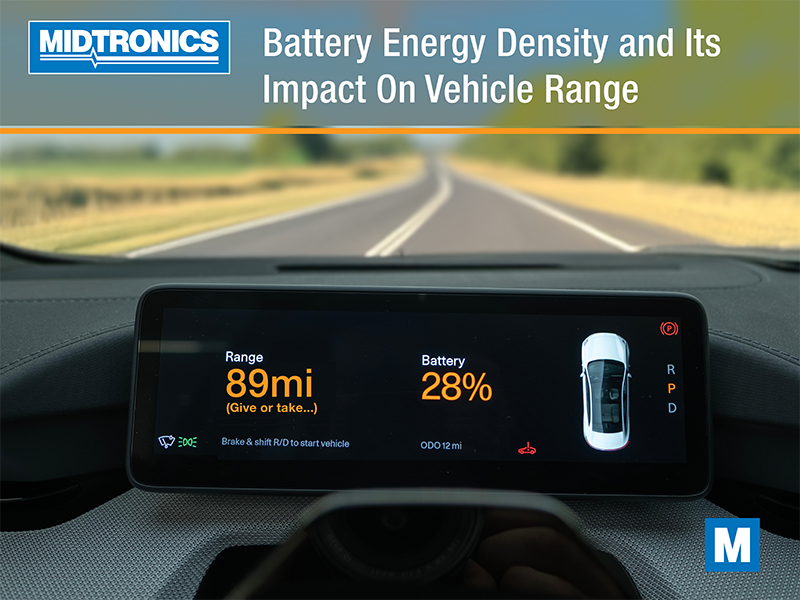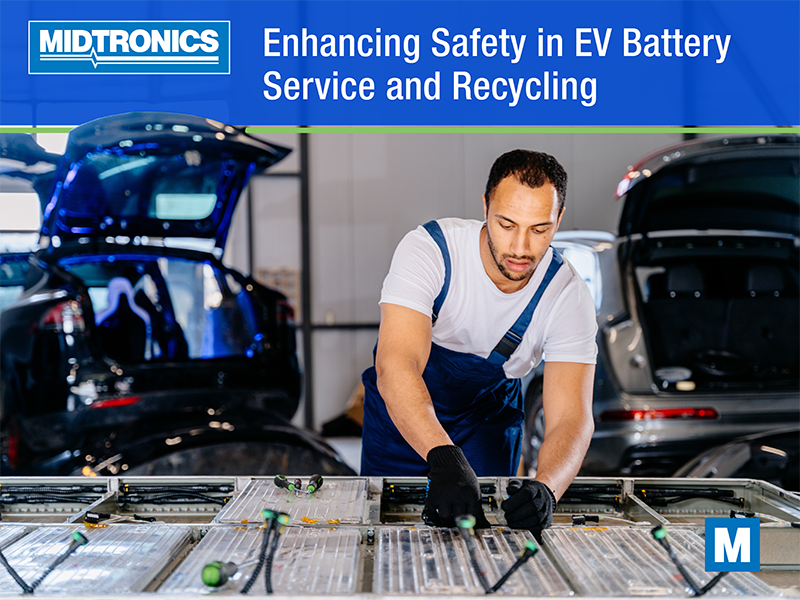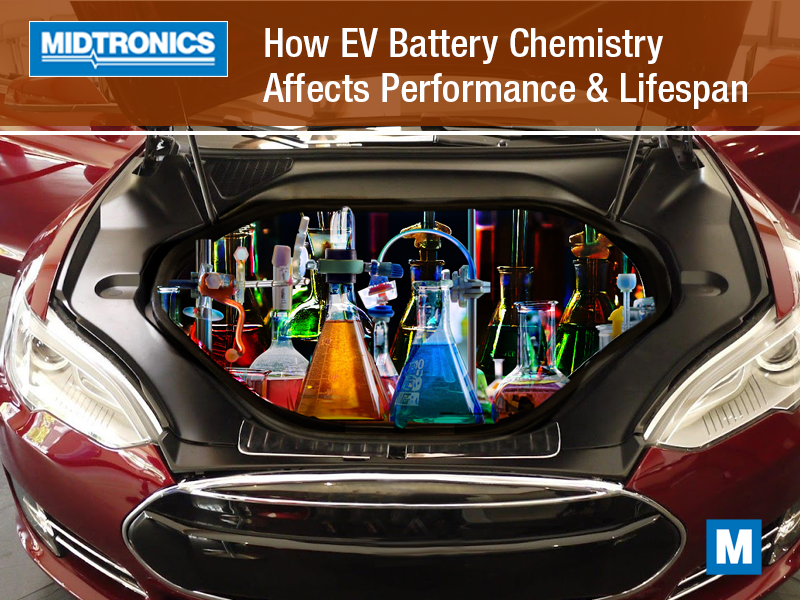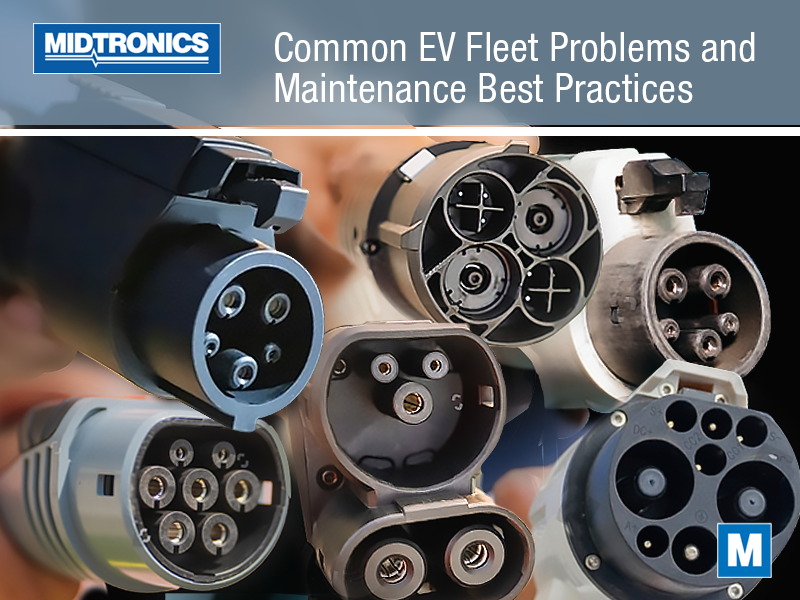Consumer demand is growing for longer range, faster charging, and improved efficiency, and one of the key factors driving EV performance is battery energy density. It’s not just for owners, though – understanding what energy density means and how it impacts vehicle range is crucial for auto professionals, especially those in service departments.
Learn why energy density matters, the various battery chemistries used in EVs, and why this knowledge is essential for service technicians and others in the shop.
Why Battery Energy Density Matters to Consumers
Battery energy density is a metric that dictates how much energy a battery can store per unit of mass or volume. Higher energy density directly translates to longer driving ranges, lower battery weights, and as a result, more efficient EVs.
For consumers, range anxiety remains one of the biggest concerns when transitioning to an EV. While advancements in charging infrastructure help shore up this issue, the primary factor in range capacity is the energy density of the battery pack. The higher the energy density, the more power an EV can store without increasing battery size or weight. This means:
- Longer driving range on a single charge.
- Faster charging times as higher-density batteries tend to have improved charging rates.
- Higher efficiency, reducing overall electricity costs per mile.
- Reduced vehicle weight, leading to better acceleration and handling characteristics.
Consumers are also increasingly aware of the trade-offs between battery performance, lifespan, and cost. A high-density battery may provide greater range, but other factors including degradation, cost, and charging cycles are considered when they make an EV purchase decision.
Battery Chemistries and Energy Density
Different battery chemistries offer varying levels of energy density. Here are the most common battery types used in modern EVs.
1. Lithium-Ion (Li-Ion) Batteries
Li-Ion batteries are the most widely used in EVs due to their high energy density and relatively long cycle life. Within this category, there are multiple subtypes with varying characteristics.
Nickel Cobalt Manganese (NCM/NMC)
With an energy density of approximately 150 to 250 Wh/kg, NCM batteries offer a high energy density and good lifespan, making them a popular choice for EVs. However, they rely on cobalt which increases costs and raises ethical sourcing concerns. On average, vehicles using NCM batteries achieve a range of 250 to 400 miles per charge, depending on battery capacity and vehicle efficiency.
Nickel Cobalt Aluminum (NCA)
NCA batteries have a slightly higher energy density of around 200 to 260 Wh/kg, making them ideal for high-performance EVs. They offer higher energy storage than NCM batteries but come with potential thermal stability issues and a higher cost due to the materials used. Vehicles equipped with NCA batteries typically provide a range of 300 to 400 miles per charge or more.
Lithium Iron Phosphate (LFP)
LFP batteries feature an energy density of approximately 90 to 160 Wh/kg. While they are lower in cost, tend to be safer, and have a longer cycle life, they provide aren’t as energy dense, which limits the range compared to NCM or NCA batteries. Vehicles powered by LFP batteries generally achieve between 150 to 300 miles per charge. This chemistry is commonly used in entry-level EVs and commercial fleets, and many mainstream carmakers are incorporating LFP battery technology.
2. Solid-State Batteries
Solid-state batteries are expected to offer an energy density between 300 to 500 Wh/kg in future models, with models from top carmakers already in testing. Their advantages include higher energy density, improved safety, and a longer lifespan. However, these batteries are still in development, face higher production costs, and come with other unknowns. Once fully tested and implemented, they could allow vehicles to achieve a range of 400 to 600+ miles per charge.
3. Other Emerging Battery Technologies
Other promising battery technologies are being worked on also. They include:
- Lithium-sulfur (Li-S) batteries, which have the potential to exceed 500 Wh/kg in energy density but currently suffer from limited cycle life.
- Sodium-ion batteries, though safer and more cost-effective than Li-Ion batteries, have a lower energy density of around 100 to 160 Wh/kg.
- Also, graphene-enhanced batteries are still in the experimental phase but show promise in terms of ultra-fast charging capabilities and increased lifespan.
Why This Knowledge is Important for Repair Shops
As the different types of batteries come to market, service and repair shops need to be prepared to handle them. Battery energy density factors into servicing for a variety of reasons.
Accurate Diagnostics and Maintenance
Different battery types degrade at different rates and require unique handling procedures. Shops need to be able to diagnose battery health accurately and recognize early signs of degradation, swelling, or thermal runaway risks. Also, service advisors should be able to advise customers on proper battery care and charging habits to make the most of battery lifespan.
Handling High-Voltage Systems Safely
Higher density batteries store significant amounts of energy, increasing the risks of electrical hazards. Technicians must be trained in safe handling and disposal of high-voltage battery packs, as well as proper insulation and protective gear to avoid shocks. Emergency procedures for battery-related fires or events should also be understood to ensure workplace and customer safety.
Deciding Repair vs. Replacement
As EVs age, customers face battery degradation issues affecting vehicle range. Understanding energy density helps technicians determine if a battery replacement is necessary or if less costly repairs are viable at the module level. It also allows them to compare different battery upgrade options as some older EVs may be retrofitted with newer, higher-density battery packs if they’re available.
Customer Education and Upselling Opportunities
Service staff can provide insights to EV owners, helping them make informed decisions about their vehicles. Educating customers on charging strategies can prolong battery life. Service departments can also offer software updates and recalibration services to make the most of battery efficiency and help extend performance.
Conclusion
Battery energy density is one of the most critical factors affecting EV performance, directly impacting everything from range to efficiency and cost. As battery technology continues to evolve, service staff must stay informed about the various chemistries and their real-world implications.
For repair shops and service technicians, this knowledge helps with diagnosing battery health, staying safe, and guiding customers in maximizing their vehicle’s lifespan. As adoption continues to rise, those who invest in servicing EV battery systems will stay at the forefront of the industry’s future.




